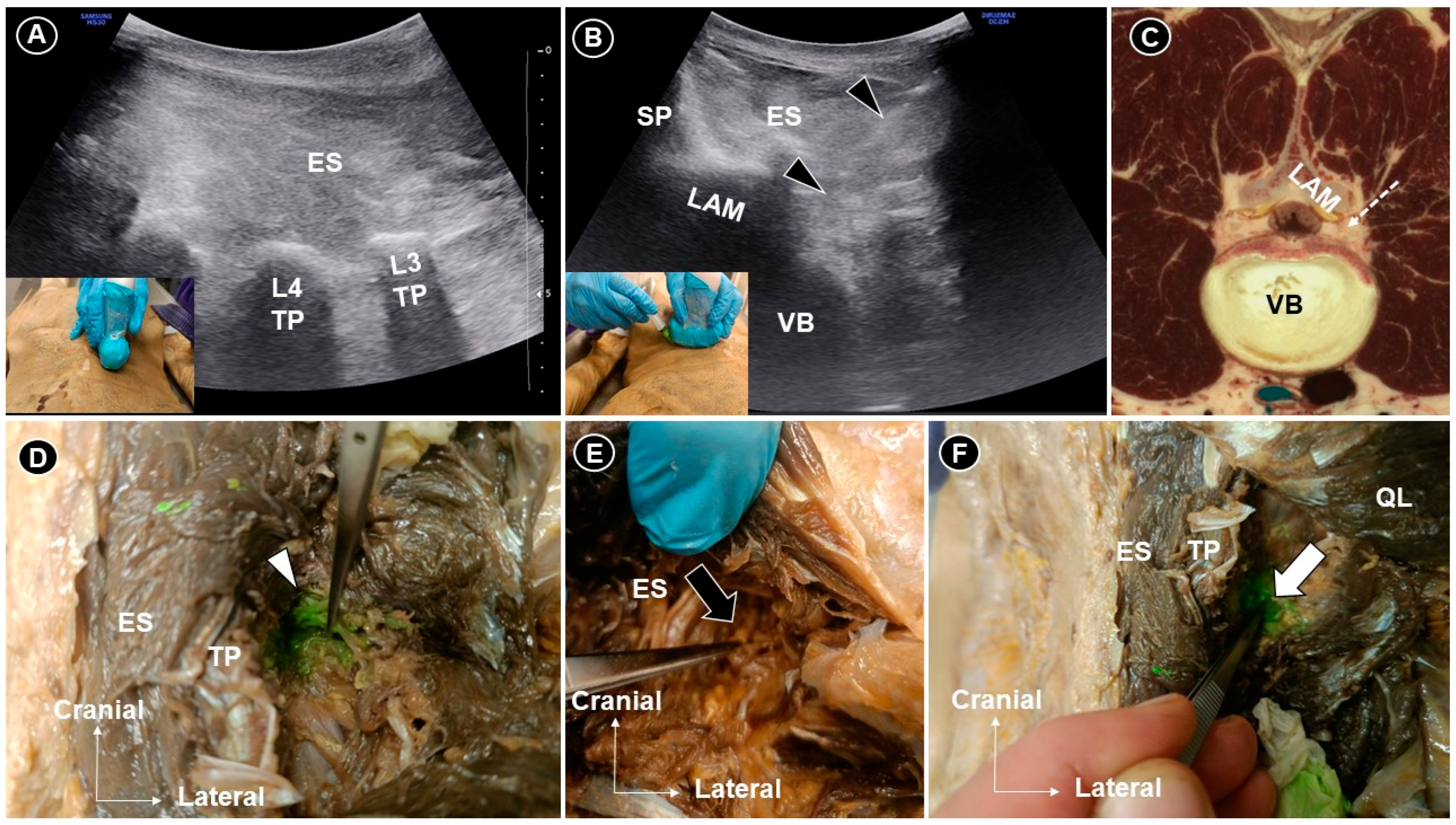Ultrasound-Guided Lumbar Plexus Injection: A Cadaveric Validation
Abstract

Author Contributions
Funding
Institutional Review Board Statement
Informed Consent Statement
Data Availability Statement
Conflicts of Interest
References
- Chang, K.V.; Kara, M.; Su, D.C.J.; Gürçay, E.; Kaymak, B.; Wu, W.T.; Özçakar, L. Sonoanatomy of the spine: A comprehensive scanning protocol from cervical to sacral region. Med. Ultrason. 2019, 21, 474–482. [Google Scholar] [CrossRef] [PubMed]
- Chang, K.V.; Lin, C.P.; Lin, C.S.; Wu, W.T.; Karmakar, M.K.; Özçakar, L. Sonographic tracking of trunk nerves: Essential for ultrasound-guided pain management and research. J. Pain Res. 2017, 10, 79–88. [Google Scholar] [CrossRef] [PubMed]
- Alexander, C.E.; Weisbrod, L.J.; Varacallo, M.A. Lumbosacral Radiculopathy. In StatPearls; StatPearls Publishing LLC.: Treasure Island, FL, USA, 2025. [Google Scholar]
- Hincapié, C.A.; Kroismayr, D.; Hofstetter, L.; Kurmann, A.; Cancelliere, C.; Rampersaud, Y.R.; Boyle, E.; Tomlinson, G.A.; Jadad, A.R.; Hartvigsen, J.; et al. Incidence of and risk factors for lumbar disc herniation with radiculopathy in adults: A systematic review. Eur. Spine J. 2025, 34, 263–294. [Google Scholar] [CrossRef] [PubMed]
- Mezian, K.; Ricci, V.; Mittal, N.; Novotný, T.; Chang, K.V.; Özçakar, L.; Naňka, O. Ultrasound-guided injection of the hip: Cadaveric description for the lateral approach. PMR 2023, 15, 1150–1155. [Google Scholar] [CrossRef] [PubMed]
- Nojiri, H.; Miyagawa, K.; Banno, S.; Sakamoto, I.; Koike, M.; Sawa, M.; Iwase, Y.; Kudo, H.; Sakai, T.; Kaneko, K. Lumbar artery branches coursing vertically over the intervertebral discs of the lower lumbar spine: An anatomic study. Eur. Spine J. 2016, 25, 4195–4198. [Google Scholar] [CrossRef] [PubMed]
- Choi, E.J.; Kim, D.H.; Han, W.K.; Lee, H.J.; Kang, I.; Nahm, F.S.; Lee, P.B. Non-Particulate Steroids (Betamethasone Sodium Phosphate, Dexamethasone Sodium Phosphate, and Dexamethasone Palmitate) Combined with Local Anesthetics (Ropivacaine, Levobupivacaine, Bupivacaine, and Lidocaine): A Potentially Unsafe Mixture. J. Pain Res. 2021, 14, 1495–1504. [Google Scholar] [CrossRef] [PubMed]
Disclaimer/Publisher’s Note: The statements, opinions and data contained in all publications are solely those of the individual author(s) and contributor(s) and not of MDPI and/or the editor(s). MDPI and/or the editor(s) disclaim responsibility for any injury to people or property resulting from any ideas, methods, instructions or products referred to in the content. |
© 2025 by the authors. Licensee MDPI, Basel, Switzerland. This article is an open access article distributed under the terms and conditions of the Creative Commons Attribution (CC BY) license (https://creativecommons.org/licenses/by/4.0/).
Share and Cite
Naňka, O.; Mezian, K.; Chang, K.-V.; Wu, W.-T.; Ricci, V.; Özçakar, L. Ultrasound-Guided Lumbar Plexus Injection: A Cadaveric Validation. Diagnostics 2025, 15, 3017. https://doi.org/10.3390/diagnostics15233017
Naňka O, Mezian K, Chang K-V, Wu W-T, Ricci V, Özçakar L. Ultrasound-Guided Lumbar Plexus Injection: A Cadaveric Validation. Diagnostics. 2025; 15(23):3017. https://doi.org/10.3390/diagnostics15233017
Chicago/Turabian StyleNaňka, Ondřej, Kamal Mezian, Ke-Vin Chang, Wei-Ting Wu, Vincenzo Ricci, and Levent Özçakar. 2025. "Ultrasound-Guided Lumbar Plexus Injection: A Cadaveric Validation" Diagnostics 15, no. 23: 3017. https://doi.org/10.3390/diagnostics15233017
APA StyleNaňka, O., Mezian, K., Chang, K.-V., Wu, W.-T., Ricci, V., & Özçakar, L. (2025). Ultrasound-Guided Lumbar Plexus Injection: A Cadaveric Validation. Diagnostics, 15(23), 3017. https://doi.org/10.3390/diagnostics15233017







